Brithdir is a small hamlet which lies just east of Dolgellau, in the ancient county of Merionethshire. The hamlet has ancient origins, being the site of a Roman Road and the remains of a Roman Fort. Within the hamlet lies the Church of St. Mark’s, which was designed by Henry Wilson and completed in 1898. Within the now disused Church is a war memorial to the members of the Parish who fell during both World Wars. One of the fallen is buried in the Churchyard. All of these men, apart from one, John Croome, are also commemorated on the war memorial at Dolgellau. The Church is under the care of the Friends of Friendless Churches, and is considered to be one of the finest Arts and Crafts Churches in Wales.
The Great War, 1914-1918
John Croome, Private, 22986, Hampshire Regiment. John was the son of William and Hannah Maria Croome, of Weeford, Staffs. He worked as a Butler for Captain Henry Meredydd Richards, of Caerynwch Hall, Brithdir prior to the war. John enlisted at Winchester into the Hampshire Regiment soon after the outbreak of war. Prior to embarking for overseas service, John married Ada Lush, a domestic servant, at Wokingham in 1916. John was posted to Salonika soon afterwards, joining the 10th Battalion, Hampshire Regiment, which was attached to 82 Brigade, 27th Division. The British had sent a strong force to Salonika in 1915 to aid its Serbian Allies, after Serbia had been invaded by a combined Austro-Hungarian and Bulgarian force, and its forces had been swept out of Serbia into Greece. A disease-ridden campaign then followed, with more men invalided through sickness and disease than wounds over the coming three years. John was killed in Salonika just weeks before the Bulgarian surrender, on 2 September 1918, aged 37. He is buried in Karasouli Military Cemetery, Greece. His former employer, Captain Richards, later offered his home for use as a Hospital. Caerynwch was opened as an Auxiliary Hospital on 17 April 1917, with accommodation for thirty men and was used throughout the rest of the war.
Evan William Evans, Corporal, 185934, Royal Engineers. Evan was the son of Robert and Anne Evans, of 43 Hafod Oer, Dolgellau. He was in education at Aberystwyth University prior to enlisting at Montgomery into the Montgomeryshire Yeomanry. He was subsequently transferred to the Royal Engineers, and posted to France, joining ‘N’ Special Company, Royal Engineers, which was a specialist gas warfare unit which used the Livens Projectors to fire gas shells. The company was initially attached to the 3rd Army, and saw service at Monchy and Auchy, before moving to Diksmuide on 9 October 1917, just north of the Ypres Salient. Evan was in action with the company, supporting their Belgian allies, when he was killed in action alongside another two men of their company on 14 November 1917. The 20-year-old is buried alongside his comrades in Steenkerke Belgian Military Cemetery, Belgium. His younger brother, Hugh Trebor Evans, had been killed just weeks earlier.
Hugh Trebor Evans, Private, 204457, Royal Welsh Fusiliers. Hugh was the son of Robert and Anne Evans, of 43 Hafod Oer, Dolgellau. He worked as a farm labourer prior to enlisted at Dolgellau into the 4th Battalion, Royal Welsh Fusiliers on 4 May 1917. After completing his training, Hugh embarked for France at Southampton on 3 August 1917, and was posted to No. 5 Infantry Base Depot at Rouen. He was then posted to the 16th Battalion, Royal Welsh Fusiliers, joining the battalion at Ypres on 25 August 1917. The battalion was attached to 113 Brigade, 38th (Welsh) Division, and had just taken part in heavy fighting during its assault on the Pilckem Ridge on 31 July. When Hugh arrived at the front, the 16th RWF was at work on the Canal Bank, supplying working parties to the troops in the front line. The battalion moved back into the front line on 30 August, but the Divisions time at Ypres was drawing to a close, and on 10 September the Division began to move to a more peaceful sector on the Lys, to rest and rebuild. On 17 September the 16th RWF moved into the front line in the Bois-Grenier Sector, to begin a routine tour of duty. On the morning of 19 September 1917, the Divisional artillery launched a barrage on the German lines, and in retaliation the Germans shelled the Divisional front with Heavy Trench Mortar fire. Hugh was among twelve men killed and 21 wounded during the day. The 19-year-old is buried in Erquinghem-Lys Churchyard Extension, France. His brother Evan was killed at Ypres some weeks later.
Hywel Evans, Private, 242715, South Lancashire Regiment. Hywel was born at Llanfachreth in 1887, the illegitimate son of Elizabeth Evans, of Penrhos Isaf. He was raised by his grandparents, Morris and Jane Evans, before becoming a carter at Felin Newydd, Rhydymain. Hywel married Jane Ellen Williams on 16 December 1913 and the couple set up home at Tyddynynoch, Brithdir. He enlisted into the South Lancashire Regiment at Wrexham on 25 October 1916, and after completing his training was posted to France on 17 February 1917, joining the 2/5th Battalion, South Lancashire Regiment. He served on the Western Front until taking ill, and returned to Britain for treatment on 23 November 1917. It was almost five months until Hywel was fit enough to re-join his unit, and he arrived back in France on 8 April 1918, before being posted to the 2/4th Battalion, South Lancashire Regiment. The battalion was attached to 172 Brigade, 57th (West Lancs) Division in the Gommecourt area. It remained here until moving to the Arras sector to take part in the launch of the great Allied offensive on 21 August 1918, and began driving towards the Hindenburg Line. The 2/4th South Lancs were in billets at Mercatel on the opening day of the offensive and on 27 August moved forwards to take up the offensive, with orders to assault the village of Hendecourt, and at 12.30 on 28 August 1918 launched its attack behind a creeping artillery barrage. Within four hours the battalion had successfully taken the village, but had suffered some losses. Hywel was among twenty men killed during the days fighting. The 31-year-old is buried in Dury Crucifix Cemetery, France. He is also commemorated on the Dinas Mawddy memorial.
Thomas Evans, Private, 89615, Royal Welsh Fusiliers. Thomas was the son of Edward and Elizabeth Evans of 3, Meirion Terrace, Brithdir, Dolgellau. He enlisted at Wrexham into the Royal Welsh Fusiliers, and was posted to France in the summer of 1918, joining the 13th Battalion, Royal Welsh Fusiliers, which was attached to 113 Brigade, 38th (Welsh) Division. He probably joined the battalion after the Division had launched its offensive across the flooded Ancre Valley on 21 August 1918, and began its slow advance towards the mighty Hindenburg Line. The Division had crossed the old Somme battlefields of 1916, taking Mametz Wood and Delville Wood, then advanced, seizing Morval and Sailly-Saillisel, before launching an attack across the Canal du Nord. Thomas was probably wounded when the 13th RWF took part in the Divisions assault on Mortho Wood, a heavily defended area, on 8 October. He was evacuated through the chain of dressing station to Casualty Clearing Stations, back to the 26th General Hospital, at Étaples, where he was being prepared to transfer back to Britain, but sadly died of his wounds there on 29 October 1918, aged 20. Thomas is buried in Étaples Military Cemetery, France. His brother, Richard, was killed in 1917.
Frederick William Harness, Private, 76278, Tank Corps. Frederick was the son of Frederick William and Elizabeth Harness of Rose Cottage, Wainfleet, Lincolnshire. He came to Dolgellau to work as a gardener prior to the war. Frederick enlisted at Dolgellau into the Royal Welsh Fusiliers soon after the outbreak of war. Frederick was then posted to the 25th Division Cyclist Company, landing in France with the unit on 26 September 1915. The Division initially moved to the Ploegsteert sector for trench initiation, then spent much of February in Strazeele. By April the Division was in the Neuville-Saint-Vaast area and defended Vimy Ridge against a German attack in May 1916. The Division then moved to the Warloy area and attacked on 3 July near Thiepval. Frederick volunteered to serve with the newly formed Tank Corps at some time afterwards. Tanks had first seen action during the Battle of Flers in September 1916, as part of the Heavy Branch Machine Gun Corps and saw further action during the Somme offensive that summer. During November 1916 D Battalion was formed from the old D Company, and joined the 1st Tank Brigade alongside C Battalion. It’s first action under this new title was at Arras on 9 April 1917, under command of the 51st (Highland) Division, in an action which saw many tanks become bogged down in soft ground, but still saw four D Battalion tanks help capture the village of Neuville-Vitasse and the attack on Telegraph Hill. On 11 April 1917, four tanks of D Battalion were in action south of Monchy, supporting an infantry assault on the Hindenburg Line, and managed to push into Wancourt, a mile beyond the line, before being forced to retreat as the infantry had not moved forward. Frederick was killed in action here during the days fighting. The 24-year-old has no known grave and is commemorated on the Arras Memorial, France.
David Jones, Private, 25546, Royal Welsh Fusiliers. David was the son of Edward and Margaret Jones, of Penrhos Isaf, Llanfachreth. He worked as a labourer prior to enlisting at Bala into the 17th Battalion, Royal Welsh Fusiliers on 27 February 1915. He was posted to Llandudno where the battalion was training as part of the newly formed 128 Brigade, 43rd (Welsh) Division. On 29 April 1915 the formation became 113 Brigade, 38th (Welsh) Division, and moved to Winchester to complete its training before moving to France on 4 December 1915. The Division then moved to the Nursery Sector near Fleurbaix for trench initiation alongside the Guards Division. The Division then took over a section of line near Cuinchy, in terrible conditions, where it remained over the coming months. By 23 June 1916 the conditions had taken their toll on David’s health, and he was admitted to the 130th Field Ambulance suffering from bronchitis. He was posted to Rouen, where he became ill again and was treated in hospital in Le Treport. Upon his recovery, he was posted to the 2nd Battalion, Royal Welsh Fusiliers, reaching the battalion on the Somme on 27 July 1916, where it was attached to 19 Brigade, 33rd Division. The Division fought throughout the Somme offensive, and by the beginning of November 1916 was in the line near Lesboeufs. Over the coming days the battalion carried out a number of raids and made an assault in support of a French attack, in dire conditions, and on the night of 7 November was relieved, marching back to La Briqueterie, then to Méaulte, where the Prince of Wales visited. David was found to be missing during the battalion roll call here, and was later found to have been captured by the Germans in the last torrid spell in the line. He was taken to a camp near Cambrai, but his health again broke down and he died at the Cambrai POW Hospital on 7 February 1917, aged 21. David was originally buried in Hendecourt-les-Cagnicourt, but the graves there were lost during fighting later in the war, so he is now commemorated on a Special Memorial within Croisilles British Cemetery, France.
Morris Jones, Private, 52043, Cheshire Regiment. Morris was the son of William and Margaret Jones, of Clywedog, Dolgellau. He lived at Bryn Deri, Abercrave, and worked as a coalminer prior to the war. He then gained work in a Munitions Factory in Middlesex, and lodged there for several months before enlisting at Uxbridge into the Royal Welsh Fusiliers on 11 December 1915. He was initially placed on the Army Reserve, but was mobilised at Hounslow on 18 March 1916, joining the 3rd Battalion, Royal Welsh Fusiliers at Litherland Camp, Liverpool. On 4 July 1916 Morris embarked for France, initially bound for the 1st Battalion, Royal Welsh Fusiliers, but on 4 September was transferred to the 13th Battalion, Cheshire Regiment, which was attached to 74 Brigade, 25th Division. The Division was on the Somme, so Morris would have seen his first action during the Somme offensive that year. The Division then moved to Ploegsteert in October 1916, and held the line for the months leading up the Battle of Messines in June 1917. The Division then had a brief rest before moving to the Railway Wood sector, at Ypres, at the end of July and took over the line at Westhoek Ridge on 1 August 1917. The trenches were in poor condition, devastated by shell-fire and waterlogged, so the Division endured a trying time there under continuous shell-fire. Morris was posted as missing on 10 August 1917, and was later deemed by a tribunal to have been killed in action on that date. The 28-year-old has no known grave and is commemorated on the Ypres (Menin Gate) Memorial, Belgium.
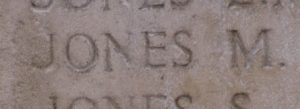
John Aneurin Owen, Private, 54612, Machine Gun Corps. John was the son of Owen Edward Owen and Jane Owen, of Tycerrig, Llanfachreth. He enlisted at Holywell into the Royal Welsh Fusiliers, and after completing his training was posted to France, joining the 47th Battalion, Machine Gun Corps. The battalion was attached to the 47th Division, and was formed in February 1918, whilst the Division was in the St. Quentin area. The Division faced the German Spring Offensive here on 21 March, and took part in an epic rear-guard action during the coming days. The fighting calmed down in this area over the coming months, after the Germans switched their attentions elsewhere. John was wounded whilst the Division was still in the area, and died of his wounds on 1 August 1918, aged 22. He is buried in Warloy-Baillon Communal Cemetery Extension, France.
Herbert Ernest Malcolm Owen, Second Lieutenant, Royal Flying Corps. Herbert, known as Malcolm, was born at Llanfairfechan on 27 October 1898, the son of Reverend Edwin James Owen and Jessie Beatrice Owen (nee Paterson). By 1901 the family was living at Coed, Brithdir, where Reverend Owen had taken over the position of Rector at St. Mark’s Church. Malcolm was educated at Ruthin Grammar School, where he excelled as a sportsman. Herbert enlisted into the Royal Flying Corps on 10 March 1917 and was posted to Reading, gaining a commission as Second Lieutenant on 30 May 1917. He was then posted to the Flying School at Hendon, to train as a pilot. Malcolm was awarded his Aviator’s Certificate on 16 June 1917, after learning to fly a Caudron biplane at the Ruffy-Bauman School. He was then posted to 60 Training Squadron, RFC. On 18 July 1917 Malcolm was flying an Avro 504, Serial A5930, from Scampton. He had just taken off, but the aircraft stalled and crashed to the ground, bursting into flames. Malcolm was knocked unconscious in the crash, thus unable to free himself from the wreckage, and despite attempts from some men to free him, he was burnt to death. The remains of the 18-year-old were conveyed home for burial in St. Mark’s Churchyard, Brithdir.

Peter Price, Private, 39140, South Wales Borderers. Peter was the son of John and Anne Price of Fronoleu, Dolgellau. He originally enlisted at Newport, Mon into the Welsh Horse Yeomanry, but did not embark for Gallipoli with the Welsh Horse in 1915, and instead transferred to the South Wales Borderers. Peter was posted to France in the Summer of 1916, joining ‘D’ Company, 1st Battalion, South Wales Borderers, which was attached to 3 Brigade, 1st Division. Peter would have seen his first action during the Somme offensive that Summer, probably during the Battles of Flers-Courcelette and Morval. The Division followed the German retreat to the Hindenburg Line in early 1917, and was then briefed for an operation on the Flanders Coast, moving there during the summer of 1917. Whilst preparing for a possible offensive along the coast, the Third Battle of Ypres had stalled in the mud, and the Division was sent to Ypres, taking part in the Second Battle of Passchendaele. After spending another Winter in Flanders, the Division was near Éstaires when the second phase of the German Spring Offensive hit the Lys Valley, and the 1st Division took part in desperate fighting over the coming days. The Division remained in the Loos sector after the fighting had died down, and enjoyed a relatively peaceful few months in the line. The 1st SWB relieved the 2nd Welsh in the line in the Cambrin North Sub-Sector on 19 July, to begin another routine tour in the trenches. At 03.00 on the morning of 22 July 1918, Second Lieutenant J. H. Hall took out one Platoon of D Company on a trench raid, to gather intelligence. Peter was killed in action during the raid that morning. The 24-year-old is buried in Cambrin Military Cemetery, France.
Arthur Pugh, Private, 2528, Welsh Guards. Arthur was the son of Hugh and Ellen Pugh, of Tynymynydd Cottage, Brithdir, Dolgellau. He served as a Policeman in Mountain Ash prior to the war, and enlisted at Mountain Ash into the newly formed 1st Battalion, Welsh Guards in February 1915. The Regiment was raised by Royal Warrant of 26 February 1915, at White City, before landing at Le Havre on 18 August 1915, becoming attached to 3rd Guards Brigade, Guards Division. The Division saw its first major action during the Battle of Loos, which began on 25 September 1915, and suffered severe casualties at Hill 70. The Guards remained in the area during the coming months, where the Division also fought in the subsequent Action of Hohenzollern Redoubt. In July 1916 the Division moved to the Somme, where it took part in the Battle of Flers-Courcelette from 15 to 22 September, the first time that tanks were used in action. Arthur was badly wounded during the battle, and was evacuated to No 3 Stationary Hospital at Rouen, where he died of his wounds on 22 September 1916, aged 22. He is buried in St. Sever Cemetery Extension, Rouen, France. His brother, Richard, died in France in 1918.
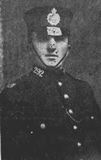
Hugh Pugh, Private, 291412, Royal Welsh Fusiliers. Hugh was the son of Hugh and Mary Pugh, of Hendregefeilliaid, Dolgellau. He worked as a Railway Porter at Corwen prior to becoming a Ministerial Student. Hugh enlisted at Dolgellau into the 7th Battalion, Royal Welsh Fusiliers on 11 December 1915 and was posted to Park Hall, Oswestry. On 6 September 1916 Hugh embarked at Devonport for Egypt, joining the 1/7th Battalion, Royal Welsh Fusiliers, which was attached to 158 Brigade, 53rd (Welsh) Division. The Division had been evacuated from Gallipoli in December 1915, moving to Egypt to join the EEF, and helped guard the Suez Canal before taking part in operations to drive the Turks out of the Sinai. The EEF then turned its attention onto driving the Turks out of Palestine, and on 26 March 1917 launched its first offensive against the coastal city of Gaza, which guarded the road to Jerusalem. Initial gains during the day were lost when the assaulting divisions lost touch with each other and communication broke down when a thick fog cloaked the battlefield. Hugh was killed in action during the desperate fighting that day. The 22-year-old has no known grave and is commemorated on the Jerusalem Memorial, Israel.
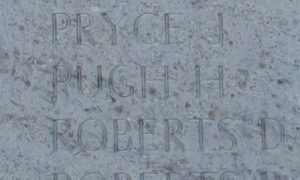
Edward Rowlands, Private, 2186, Welsh Guards. Edward was the son of Thomas and Catherine Rowlands, of Lletty Canol, Brithdir, Dolgellau. He worked on his father’s farm prior to enlisting at Dolgellau into the Welsh Guards. The Regiment was raised by Royal Warrant of 26 February 1915, at White City, before landing at Le Havre on 18 August 1915, becoming attached to 3rd Guards Brigade, Guards Division. The Division saw its first major action during the Battle of Loos, which began on 25 September 1915, suffering heavy casualties at Hill 70, and also saw further fighting at the subsequent Action of Hohenzollern Redoubt. The Guards then wintered in the Ypres Salient, before moving to the Somme at the end of July 1916 and took over positions at Beaumont Hamel for a short while. On 25 August the Guards moved slightly south, to Maricourt, to begin preparations for the forthcoming Battle of Flers-Courcelette, the first time that tanks would be used in action. By now, however, Edward had taken ill and had been evacuated to the 39th Casualty Clearing Station at Allonville, where he died of dysentery on 11 September 1916, aged 23. He is buried in Allonville Communal Cemetery, France.
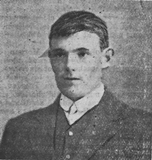
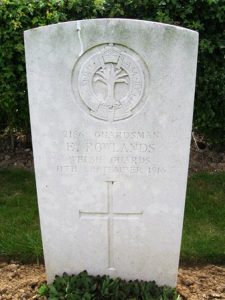
World War Two, 1939-1945
Lewis Evans, Sergeant, 1212800, Royal Air Force Volunteer Reserve. Lewis was the son of Rowland Evans and Magdalene Evans (nee Edwards), of Brithdir. He enlisted into the Royal Air Force Volunteer Reserve, and trained as a Pilot before being posted to 165 Squadron, RAF. The squadron had reformed at RAF Ayr on 6 April 1942, equipped with Supermarine Spitfires. Lewis appears to have been aboard the aircraft carrier HMS Eagle, and was lost in the Mediterranean after taking off from Eagle on 21 July 1942. Lewis was 23 years old when he died that day and is commemorated on the Malta Memorial, Malta.
Ifor Wyn Pugh, Sergeant, 1583491, Royal Air Force Volunteer Reserve. Ifor was the son of Hugh Pugh and Catherine Pugh (nee Roberts), of Bontddu. He enlisted into the Royal Air Force Volunteer Reserve and trained as a Flight Engineer before being posted to 427 Squadron, RAF. The Squadron had formed on 7 November 1942 at RAF Croft as part of No. 4 Group. Two months later the Squadron was transferred to No. 6 (Royal Canadian Air Force) Group, initially equipped with the Vickers Wellington. The Squadron moved to RAF Leeming in May 1943 and re-equipped with the Handley Page Halifax four-engine bomber. On the night of 17 August 1943, Ifor took off from RAF Leeming aboard Halifax V, Serial DK243, which was part of a force despatched to bomb the Nazi rocket research centre at Peenemünde. The raid was a success, causing heavy damage at the facility, and the surviving bombers began their return flight. Soon afterwards, Ifor’s aircraft was intercepted by a German night-fighter and was hit. Only two men managed to bale out, Ifor and four others were killed when their Halifax crashed at Wusterhusen on the morning of 18 August 1943. Ifor was 19-years-old when he was killed during the crash and is buried alongside his fellow crew members in Berlin 1939/45 War Cemetery, Germany.